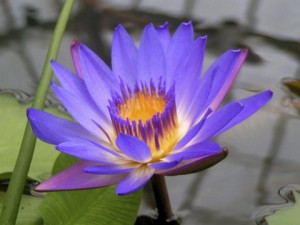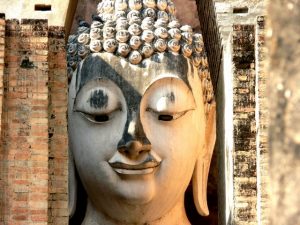Overview of Practice
When we add meditation to our routine we begin a process that can grow and transform our lives, even when we’re not aware of its doing so. Having confidence in the power and goodness of our practice right from the start can make it easier to meditate regularly and prepare us for the new awareness that meditation brings. We can nurture this faith in our practice by noticing and appreciating its benefits, beginning with relaxation. It also helps to have an idea where this path we’re following leads.
Just shifting our attention to the bodily sensations of breathing takes our energy away from the incessant thinking that crowds our minds. As a result the tumult of thought subsides, and we very pleasantly relax, like when a jackhammer suddenly falls silent. It may take a while to notice this pleasure during meditation, but it’s worth intentionally noting it because it builds the faith that can sustain our practice in the future.
A more relaxed and concentrated mind can then begin to notice thoughts as they arise. Unfortunately, when we’re fairly new to meditation and notice the multitude of thoughts swirling around our minds, we tend to feel that we’re failing at the business of paying attention to breathing. This attitude misses the big point, though. When we can be aware of the flow of thoughts, we’ve achieved a level of mindfulness usually absent in our daily routine. We’re now actually watching ourselves think, rather than our usual state of being absorbed by (or lost in) thoughts.
While meditating, we’re returning the attention to the breath over and over, noticing thoughts in between. Doing this creates a kind of “split screen” in the mind. We’re aware of the somatic experience of breathing, and we’re aware of thoughts that arise. Because we keep in touch with our physical sensations, we can also observe the way thoughts make us feel in the body, emotionally. This is a revolutionary awareness which can give us unprecedented control over our lives and freedom from many forms of suffering. Bringing acceptance to the moment when we realize we’re lost in thought lets us reap these benefits of mindfulness. It also nourishes the seeds of compassion – for ourselves and all other suffering minds – which is vital to the growth of our practice.
Becoming aware of the normal chaos in the mind is often the meditator’s first encounter with avoidable stress (or “suffering”), and the first instance of seeing that this suffering originates inside our own minds. Many reactions can occur: frustration at not being able to control this thinking, aversion to the kind of thoughts and emotions that arise repeatedly (and don’t quite fit our image of ourselves), and a sense of being to blame for it all, etc. A lot of people walk away from practice at this point. Unfortunately they’re overlooking the fact that being able to see the suffering caused by their thoughts put them in a position to begin to change them. Not immediately, but gradually, if they continue to meditate.
Seeing the value of continuing to practice with this unruly human mind puts us squarely on a path that leads to freedom from suffering. Really. This has been proven by countless people who’ve followed this path in the 2,500 years since Buddha first taught others about the transformation he achieved. The first lesson he taught others was on the Four Noble Truths, that: 1) our lives are filled with suffering, 2) which is caused by our clinging to things, 3) but this can be changed, 4) by doing what he did.
The first Noble Truth is often much harder to appreciate than it seems at first. It’s quite common (perhaps universal) to be deeply confused about the real nature of suffering and happiness. The human mind tends to see experiences (good, bad or indifferent) as the result of causes “out there” in the world. Naturally, then, we tend to seek things that cause good experiences, avoid things that cause bad ones and ignore things that cause indifferent experiences. Buddha’s teachings, or “the Dharma,” turns all that at an angle which gives us a very different view of what it means to be happy, or not.
The Buddha showed that the genesis of suffering or happiness is not in the “outside world” but in the mind itself, where we can gain much greater control over our suffering. Our “quality of life” does not really depend on things like the economy, our surroundings, other people, or possessions. This is good, because we’re usually fairly powerless over these things anyway. When was the last time you had everything you wanted – and everything worked just the way you wanted?
As we continue with our meditation practice, we beginto see what Buddha meant about the cause of suffering. When we’ve spent some time noticing our thoughts, without being sucked into them, we begin to see the patterns in our thinking. And, because we’ve kept returning our attention to the physical sensations of breathing, we get familiar with the way our bodies react to certain thought habits. Eventually it becomes clear to us: our emotional state results from our thoughts about things and events, not from the external circumstances themselves. For example, we can be happy when given something we don’t want if we’re fond of the giver, or we could focus on the gift and be disappointed. It’s our choice. When we cling to an idea of what we want, we set ourselves up to suffer. And we do it all the time.
Realizing this does not lead to passivity in the face of circumstances over which we do have some control. In fact, it leads to a much higher capacity for taking appropriate action, because our minds will not be clouded by such powerful feelings of greed or aversion. Freeway driving offers many illustrations. When someone suddenly moves into my lane right in front of me, reacting with anger not only causes me to suffer through an unpleasant emotional response, it may also impair my ability to avoid a collision. That’s clear enough, but seeing the logic of it isn’t sufficient to keep me from getting angry or nursing that unpleasant emotion for miles.
It takes practice. It takes meditating regularly, confident that seeing the way the mind works will eventually change it. Along with this change in the habits of the mind will come a change in the way we see… the mind, the heart, ourselves, and others. The practice will bring about these changes naturally. We don’t need to do them. In fact, we need to give up the idea that we can think or will our way around our harmful mental habits. We need to have the courage to get up close to our patterns, to get familiar with how we create and reinforce them, and to watch ourselves fall into them, yet again. Eventually, when we don’t even know it, something shifts inside us and lets go. It’s as if we finally see that we’ve been clinging to a hot coal, and really felt the harm that has caused. For this process to work all the way through, it’s essential that we open our hearts and have compassion for ourselves and the suffering that years of bad mental habit still cause us, and others.
This isn’t easy. That’s why Buddha gave his new disciples Three Refuges, places to stand safe and steady as we confront all the suffering in our own hearts and in the world around us. They are our own innate capacity to become awakened, (a Buddha); the teachings that have shown millions the way for over 2.5 millennia (the Dharma), and those individuals who have carried these teachings and supported each other on this path (the Sangha). Meditating with a group and having a teacher to consult are indispensable supports to this practice, as it continues to transform our lives. When we get upset because we’ve reacted in “that same old pattern” another time, our sangha and teacher can remind us that we’ve actually made tremendous progress because we could see the pattern operate. Eventually, if we keep watching it, that habitual reaction will weaken. Then a day will come when we realize it’s been a while since we’ve reacted that way at all. Then we taste a new, sweet level of freedom.
As our meditation practice and life begin to intermix, we realize that this is not just about watching the breath. We’re actually re-training our minds. Our minds have been like puppies that grew up without any training and become the kind of dogs that bark and chew the furniture. They need re-training. So we’ve gone to a very deep level to change patterns that have set in deeply. And we need to do this with compassion for ourselves and for the kind of suffering we share with all others. A dog trained with love will be a help and a good companion. One trained harshly could be dangerous.
We are now noticing an increasing number of moments when we’re aware of our thoughts and emotions, and the choices we have. Our hearts are opening to our own suffering and that of all other beings. There’s so much more that matters than our momentary likes and dislikes. Naturally, we begin to want more understanding and guidance about this practice that has begun to permeate our lives.
The Fourth Noble Truth offers an Eightfold Path that moves us through the areas of Wisdom, Ethics and Practice to liberation. There’s no linear sequence to the ‘folds’ of the path. People can start in one area, jump to another or work on several at once. Sometimes we learn the same thing often, in different contexts, as we grow in wisdom. Eventually we see that it’s all connected, just like everything in life. As we understand the nature of suffering and its causes, we form the intent to end it and to foster happiness for ourselves and others.
That puts us into action, where the importance of our conduct becomes even clearer. Back on the freeway, if I’d blared my horn to scold that driver who cut in front of me, it would have increased the anger I experienced as well as inviting the other driver to have a negative response. In other words, acting out of negative mind states causes further suffering for me and others. In contrast, if I’d just honked to warn of a possible collision, it wouldn’t have affected me so strongly, and possibly not the other driver, either. Realizing this, we resolve to be mindful of our conduct in the areas of speech, physical action and livelihood.
And of course, we continue meditation practice. We’re familiar with paying attention to one thing (concentration) and noticing what we experience (mindfulness). With these abilities we can make the effort to direct our attention wisely, so that the patterns that cause suffering will fade and the conditions in which happiness thrives will flourish. As we continue meeting the truth of our experience with clear, compassionate attention, our lives improve in many ways. Our stress level goes down, our judgment gets better, our relationships with others improve, and we live with a greater sense of ease. When life continues presenting challenges, it’s vital to appreciate how far practice has brought us, so that we can continue growing.
When I began meditating, I encountered lots of numbered lists that made little sense to me. I really loved the relaxation that came with meditating and I wanted to keep doing it just for that. Let others read those lists. Then I got to a stage in my practice when I became curious. What exactly is suffering, how can it be ended, what is wise speech or those other ethical guidelines? Before I knew it, I owned books that I’d actually read, went to workshops and daylong sittings, joined a sangha and went on retreats. I did this not because I felt I ought to, but because I simply wanted to see what the next step on the path would reveal, or to understand better what I’d already seen.
The Buddha lived at a time when there were a lot of teachers, a lot of excitement about the potential of the heart and mind. So do we. There are a lot of resources available to us on the web, the book shelf, your local sangha. Gifted teachers abound. We are incredibly fortunate to be aware human beings at this point in history, and our own awakening can be a powerful force for a better future for all beings. We don’t have to have a lofty, nearly impossible resolve to fulfill this potential, either. We just have to keep meditating and have faith as our practice unfolds in – and transforms – our lives.



